Cohen I.M., Kundu P.K. Fluid Mechanics
Подождите немного. Документ загружается.

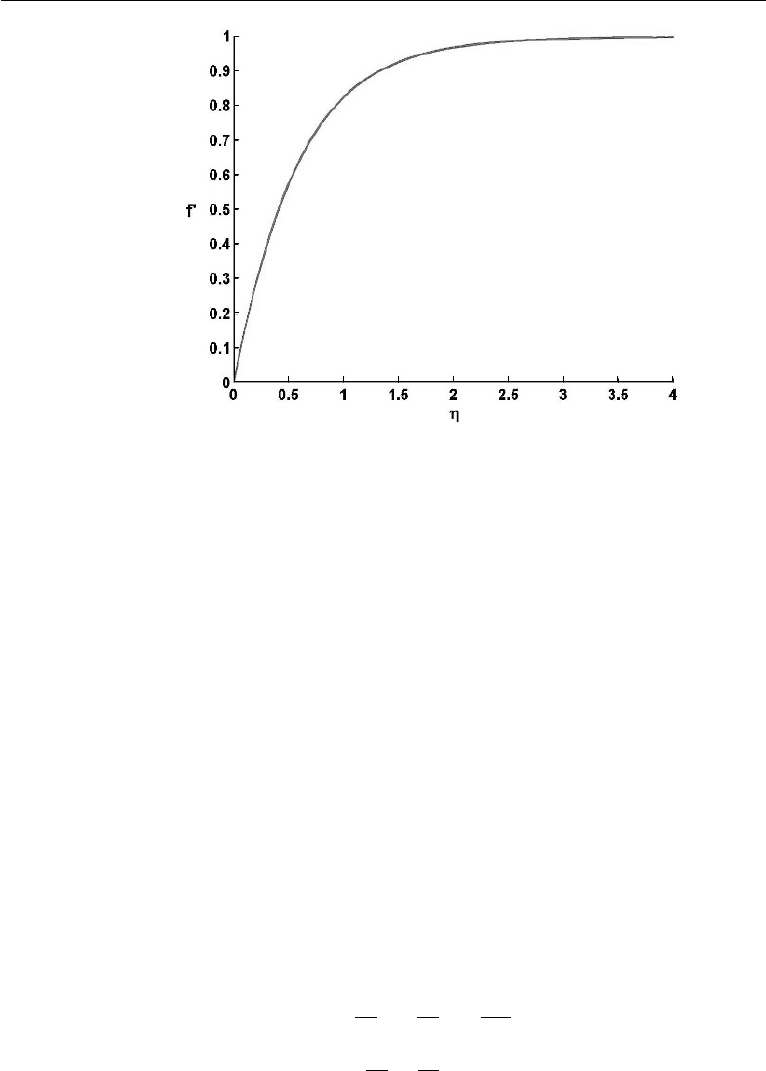
352 Boundary Layers and Related Topics
Figure 10.6 Dimensionless velocity profile for flow illustrated in Figure 10.5.
5. Boundary Layer on a Flat Plate: Blasius Solution
We shall next discuss the classic problem of the boundary layer on a semi-infinite
flat plate. Equations (10.8)–(10.10) are a valid asymptotic representation of the full
Navier–Stokes equations in the limit Re
x
→∞. Thus with x measured from the
leading edge, the initial station x
0
(see equation (10.15)) must be sufficiently far
downstream that U
e
x
0
/ν 1. A major question in boundary layer theory is the
extent of downstream memory of the initial state. If the external stream U
e
(x) admits
a similarity solution, is the initial condition forgotten and how soon? Serrin (1967)
and Peletier (1972) showed that for favorable pressure gradients (U
e
dU
e
/dx) of
similarity form, the initial condition is forgotten and the larger the acceleration the
sooner similarity is achieved. A decelerating flow will accentuate details of the initial
state and similarity will never be found despite its mathematical admissability. This
is consistent with the experimental findings of Gallo et al. (1970). A flat plate for
which U
e
(x) = U = const. is the borderline case; similarity is eventually achieved
here. In the previous problem, the sink creates a rapidly accelerating flow so that, if
we could ever realize such a flow, similarity would be achieved quickly.
As the inviscid solution gives u = U = const. everywhere, ∂p/∂x = 0 and the
equations become
u
∂u
∂x
+ v
∂u
∂y
= ν
∂
2
u
∂y
2
,
∂u
∂x
+
∂v
∂y
= 0,
(10.19)

5. Boundary Layer on a Flat Plate: Blasius Solution 353
subject to: y = 0: u = v = 0,x>0
y → overlap at edge of boundary layer: u → U,
x = x
0
: u(y) given, Re
x
0
1.
(10.20)
For x large compared with x
0
, we can argue that the initial condition is forgotten.
With x
0
no longer available for rendering the independent variables dimensionless, a
similarity solution will be obtained. Using our previous results,
ψ(x, y) =
√
νU xf (η), η =
y
x
Re
x
, Re
x
=
Ux
ν
,
and u = ∂ψ/∂y, v =−∂ψ/∂x.Nowu/U = f
(η) and
f
+
1
2
ff
= 0,
f(0) = f
(0) = 0,f(∞) = 1.
A different but equally correct method of obtaining the similarity form is described in
what follows. The plate length L (Figure 10.4) has been taken very large so a solution
independent of L has been sought. In addition, we limit our consideration to a domain
far downstream of x
0
so the initial condition has been forgotten.
Similarity Solution—Alternative Procedure
We shall regard δ(x) as an unknown function in the following analysis; the form
of δ(x) will follow from a requirement that a similarity solution must exist for this
problem.
As there is no externally imposed length scale along x, the solutions at various
downstream locations must be self similar. Blasius, a student of Prandtl, showed
that a similarity solution can indeed be found for this problem. Clearly, the velocity
distributions at various downstream points can collapse into a single curve only if the
solution has the form
u
U
= g(η), (10.21)
where
η =
y
δ(x)
. (10.22)
At this point it is useful to pause a little and compare the situation with that of
a suddenly accelerated plate (see Chapter 9, Section 7), for which similarity solu-
tions exist. In that case we argued that the parameter U drops out of the equations
and boundary conditions if we define u/U as the dependent variable, leading to
u/U = f (y, t,ν). A dimensional analysis then immediately showed that the func-
tional form must be u/U = F [y/δ(t)], where δ(t) ∼
√
νt. In the current problem the
downstream distance is timelike, but we cannot analogously write u/U = f (y, x, ν),
because ν cannot be made nondimensional with the help of x or y. The dynamic

354 Boundary Layers and Related Topics
reason for this is that U cannot be eliminated from the problem simply by regarding
u/U as the dependent variable, because U still remains in the problem through the
dependence of δ on U. The correct dimensional argument in this case is that we must
have a solution of the form u/U = g[y/δ(x)], where δ(x) is a function of (U,x,ν)
and therefore can only be of the form δ ∼
√
νx/U.
We now resume our search for a similarity solution for the flat plate boundary
layer. As the problem is two-dimensional, it is easier to work with the streamfunction
defined by
u ≡
∂ψ
∂y
,v≡−
∂ψ
∂x
.
Using the similarity form (10.21), we obtain
ψ =
y
0
udy = δ
η
0
udη = δ
η
0
Ug(η) dη = Uδf(η), (10.23)
where we have defined
g(η) ≡
df
dη
. (10.24)
(Equation (10.23) shows that the similarity form for the stream function is ψ/Uδ =
f(η), signifying that the scale for the streamfunction is proportional to the local flow
rate Uδ.)
In terms of the streamfunction, the governing sets (10.19) and (10.20) become
∂ψ
∂y
∂
2
ψ
∂x ∂y
−
∂ψ
∂x
∂
2
ψ
∂y
2
= ν
∂
3
ψ
∂y
3
, (10.25)
subject to
∂ψ
∂y
= ψ = 0aty = 0,x>0,
∂ψ
∂y
→ U as
y
δ
→∞.
(10.26)
To express sets (10.25) and (10.26) in terms of the similarity streamfunction
f(η), we find the following derivatives from equation (10.23):
∂ψ
∂x
= U
f
dδ
dx
+ δ
∂f
∂x
= U
dδ
dx
[f − f
η], (10.27)
∂
2
ψ
∂x ∂y
= U
dδ
dx
∂
∂y
[f − f
η]=−
Uηf
δ
dδ
dx
, (10.28)
∂ψ
∂y
= Uf
, (10.29)

5. Boundary Layer on a Flat Plate: Blasius Solution 355
∂
2
ψ
∂y
2
=
Uf
δ
, (10.30)
∂
3
ψ
∂y
3
=
Uf
δ
2
, (10.31)
where primes on f denote derivatives with respect to η. Substituting these derivatives
in equation (10.25) and canceling terms, we obtain
−
Uδ
ν
dδ
dx
ff
= f
. (10.32)
In equation (10.32), f and its derivatives do not explicitly depend on x. The equation
can be valid only if
Uδ
ν
dδ
dx
= const.
Choosing the constant to be
1
2
for eventual algebraic simplicity, an integration gives
δ =
νx
U
. (10.33)
Equation (10.32) then becomes
1
2
ff
+ f
= 0. (10.34)
In terms of f , the boundary conditions (10.26) become
f
(∞) = 1,
f(0) = f
(0) = 0.
(10.35)
A series solution of the nonlinear equation (10.34), subject to equation (10.35),
was given by Blasius. It is much easier to solve the problem with a computer, using for
example the Runge–Kutta technique. The resulting profile of u/U = f
(η) is shown
in Figure 10.7. The solution makes the profiles at various downstream distances
collapse into a single curve of u/U vs y
√
U/νx, and is in excellent agreement with
experimental data for laminar flows at high Reynolds numbers. The profile has a
point of inflection (that is, zero curvature) at the wall, where ∂
2
u/∂y
2
= 0. This
is a result of the absence of pressure gradient in the flow and will be discussed in
Section 7.
Matching with External Stream
We find in this case that the difference between f
and 1 ∼ (1/η)e
−η
2
/4
→ 0
exponentially fast as η →∞.
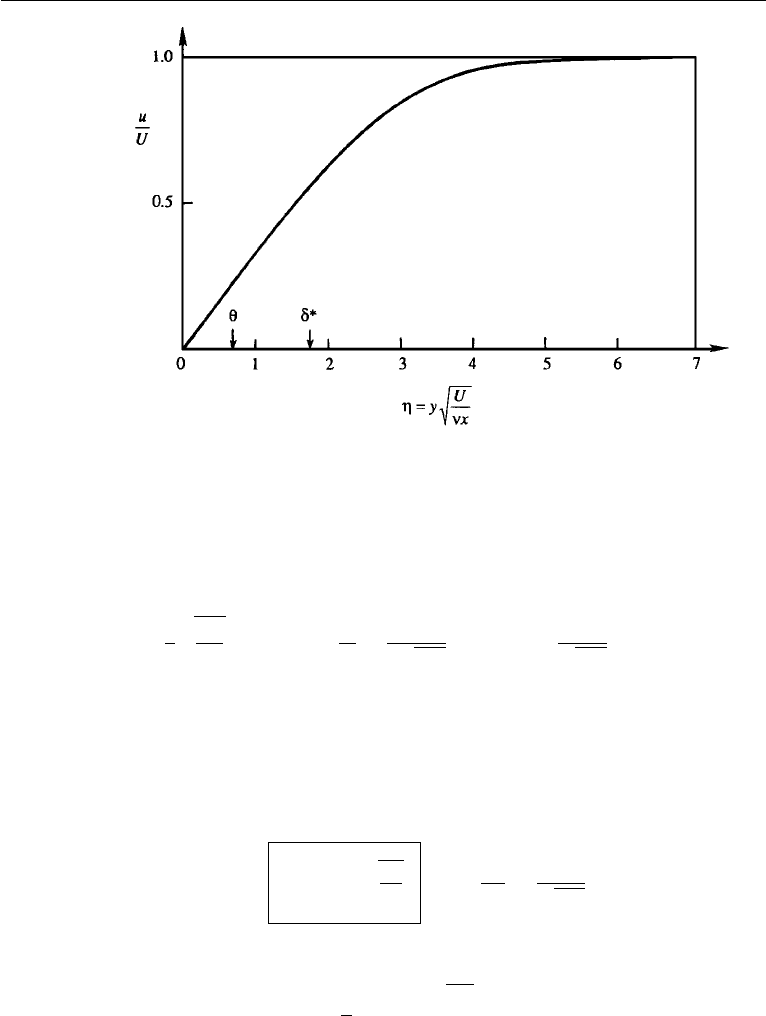
356 Boundary Layers and Related Topics
Figure 10.7 The Blasius similarity solution of velocity distribution in a laminar boundary layer on a flat
plate. The momentum thickness θ and displacement δ
∗
are indicated by arrows on the horizontal axis.
Transverse Velocity
The lateral component of velocity is given by v =−∂ψ/∂x. From equation (10.27),
this becomes
v =
1
2
νU
x
(ηf
− f),
v
U
=
1
2
√
Re
x
(ηf
− f) ∼
0.86
√
Re
x
as η →∞,
a plot of which is shown in Figure 10.8. The transverse velocity increases from zero
at the wall to a maximum value at the edge of the boundary layer, a pattern that is in
agreement with the streamline shapes sketched in Figure 10.4.
Boundary Layer Thickness
From Figure 10.7, the distance where u = 0.99 U is η = 4.9. Therefore
δ
99
= 4.9
νx
U
or
δ
99
x
=
4.9
√
Re
x
, (10.36)
where we have defined a local Reynolds number
Re
x
≡
Ux
ν
The parabolic growth (δ ∝
√
x) of the boundary layer thickness is in good agree-
ment with experiments. For air at ordinary temperatures flowing at U = 1m/s, the
Reynolds number at a distance of 1 m from the leading edge is Re
x
= 6 × 10
4
, and
equation (10.36) gives δ
99
= 2 cm, showing that the boundary layer is indeed thin.
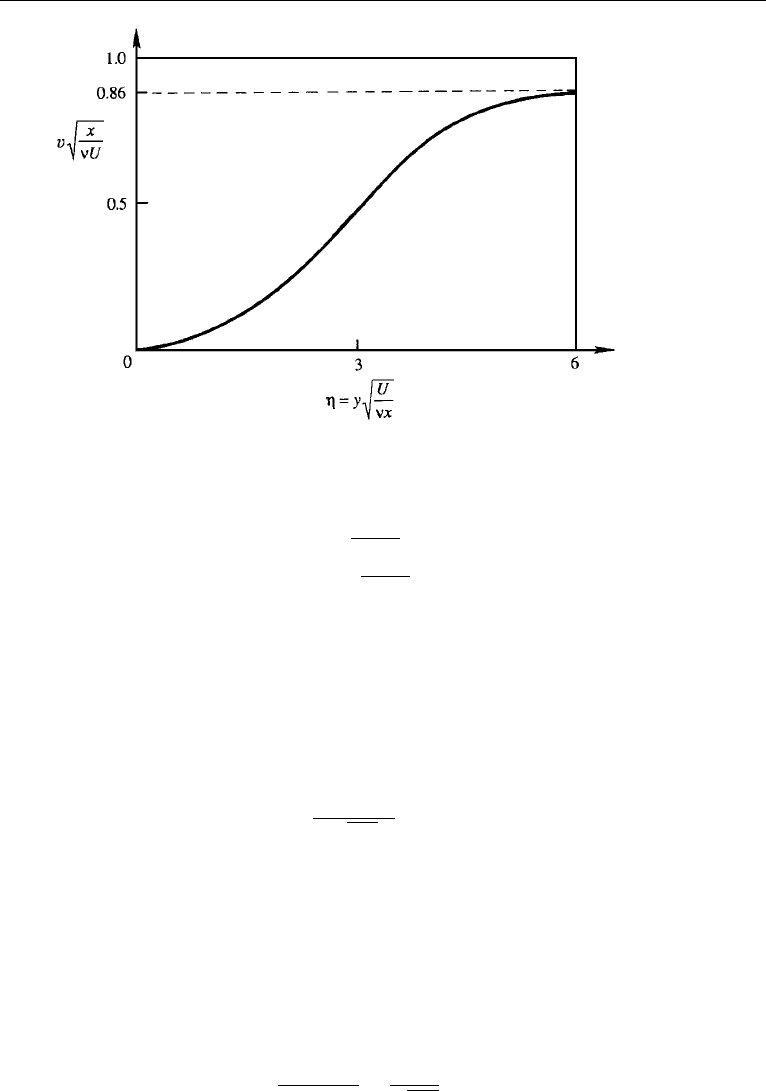
5. Boundary Layer on a Flat Plate: Blasius Solution 357
Figure 10.8 Transverse velocity component in a laminar boundary layer on a flat plate.
The displacement and momentum thicknesses, defined in equations (10.16) and
(10.17), are found to be
δ
∗
= 1.72
νx/U,
θ = 0.664
νx/U.
These thicknesses are indicated along the abscissa of Figure 10.7.
Skin Friction
The local wall shear stress is τ
0
= µ(∂u/∂y)
0
= µ(∂
2
ψ/∂y
2
)
0
, where the subscript
zero stands for y = 0. Using ∂
2
ψ/∂y
2
= Uf
/δ given in equation (10.30), we obtain
τ
0
= µUf
(0)/δ, and finally
τ
0
=
0.332ρU
2
√
Re
x
. (10.37)
The wall shear stress therefore decreases as x
−1/2
, a result of the thickening of the
boundary layer and the associated decrease of the velocity gradient. Note that the
wall shear stress at the leading edge is predicted to be infinite. Clearly the boundary
layer theory breaks down near the leading edge where the assumption ∂/∂x ∂/∂y
is invalid. The local Reynolds number Re
x
in the neighborhood of the leading edge
is of order 1, for which the boundary layer assumptions are not valid.
The wall shear stress is generally expressed in terms of the nondimensional skin
friction coefficient
C
f
≡
τ
0
(1/2)ρU
2
=
0.664
√
Re
x
. (10.38)
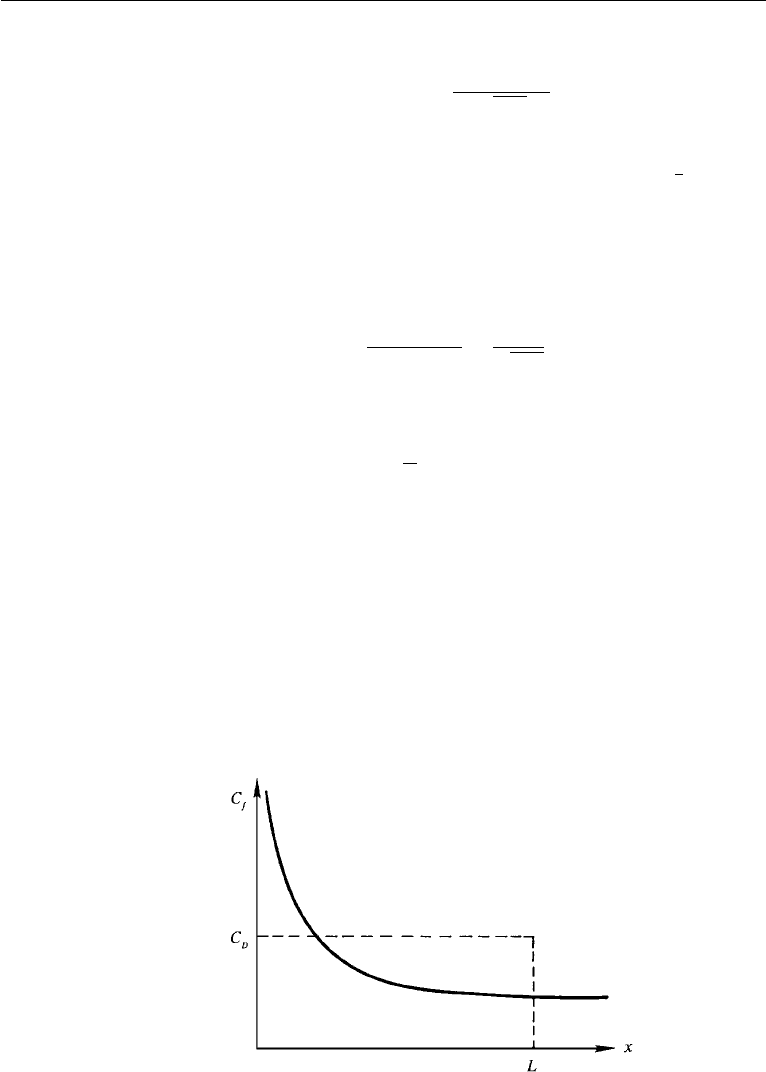
358 Boundary Layers and Related Topics
The drag force per unit width on one side of a plate of length L is
D =
L
0
τ
0
dx =
0.664ρU
2
L
√
Re
L
,
where we have defined Re
L
≡ U L/ν as the Reynolds number based on the plate
length. This equation shows that the drag force is proportional to the
3
2
power of
velocity. This should be compared with small Reynolds number flows, where the
drag is proportional to the first power of velocity. We shall see later in the chapter
that the drag on a blunt body in a high Reynolds number flow is proportional to the
square of velocity.
The overall drag coefficient defined in the usual manner is
C
D
≡
D
(1/2)ρU
2
L
=
1.33
√
Re
L
. (10.39)
It is clear from equations (10.38) and (10.39) that
C
D
=
1
L
L
0
C
f
dx,
which says that the overall drag coefficient is the average of the local friction coeffi-
cient (Figure 10.9).
We must keep in mind that carrying out an integration from x = 0isof
questionable validity because the equations and solutions are valid only for very
large Re
x
.
Falkner–Skan Solution of the Laminar Boundary Layer Equations
No discussion of laminar boundary layer similarity solutions would be complete
without mention of the work of V. W. Falkner and S. W. Skan (1931). They found
Figure 10.9 Friction coefficient and drag coefficient in a laminar boundary layer on a flat plate.
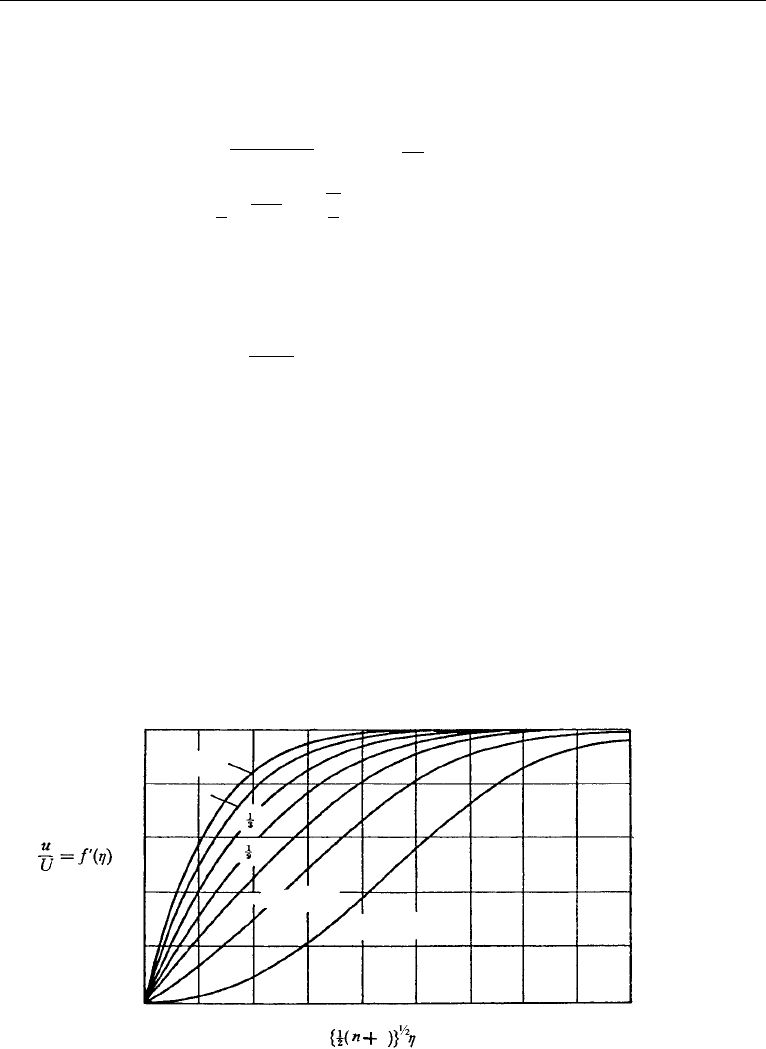
5. Boundary Layer on a Flat Plate: Blasius Solution 359
that U
e
(x) = ax
n
admits a similarity solution, as follows. We assume that Re
x
=
ax
(n+1)
/ν is sufficiently large so that the boundary layer equations are valid and any
dependence on an initial condition has been forgotten. Then the initial station x
0
disappears from the problem and we may write
ψ(x, y) =
νU
e
(x) · x f (η) =
√
νa x
(n+1)/2
f(η),
η =
y
x
Re
x
=
a
ν
yx
(n−1)/2
.
Then u/U
e
= f
(η) and U
e
(dU
e
/dx) = na
2
x
2n−1
.
The x-momentum equation reduces to the similarity form
f
+
n + 1
2
ff
− nf
2
+ n = 0, (10.40)
f(0) = 0,f
(0) = 0,f
(∞) = 1. (10.41)
The Blasius equation (10.34) and (10.35) is a special case for n = 0, that is,
U
e
(x) = U . Although there are similarity solutions possible for n<0, these are not
likely to be seen in practice. For n 0, all solutions of equations (10.40) and (10.41)
have the proper behavior as detailed in the preceding. The numerical coefficients
depend on n. Solutions to equations (10.40) and (10.41) are displayed in Figure 5.9.1
of Batchelor (1967) and reproduced here in Figure 10.10. They show a monotonically
increasing shear stress [f
(0)]asn increases. For n =−0.0904,f
(0) = 0soτ
0
= 0
and separation is imminent all along the surface. Solutions for n<−0.0904 do not
represent boundary layers. In most real flows, similarity solutions are not available
and the boundary layer equations with boundary and initial conditions as written in
1.0
0.8
0.6
0.4
0.2
01
1
234
– 0.0904
– 0.0654
0
1
n =4
Figure 10.10 Velocity distribution in the boundary layer for external stream U
e
= ax
n
. G. K Batchelor,
An Introduction to Fluid Dynamics, 1st ed. (1967), reprinted with the permission of Cambridge University
Press.
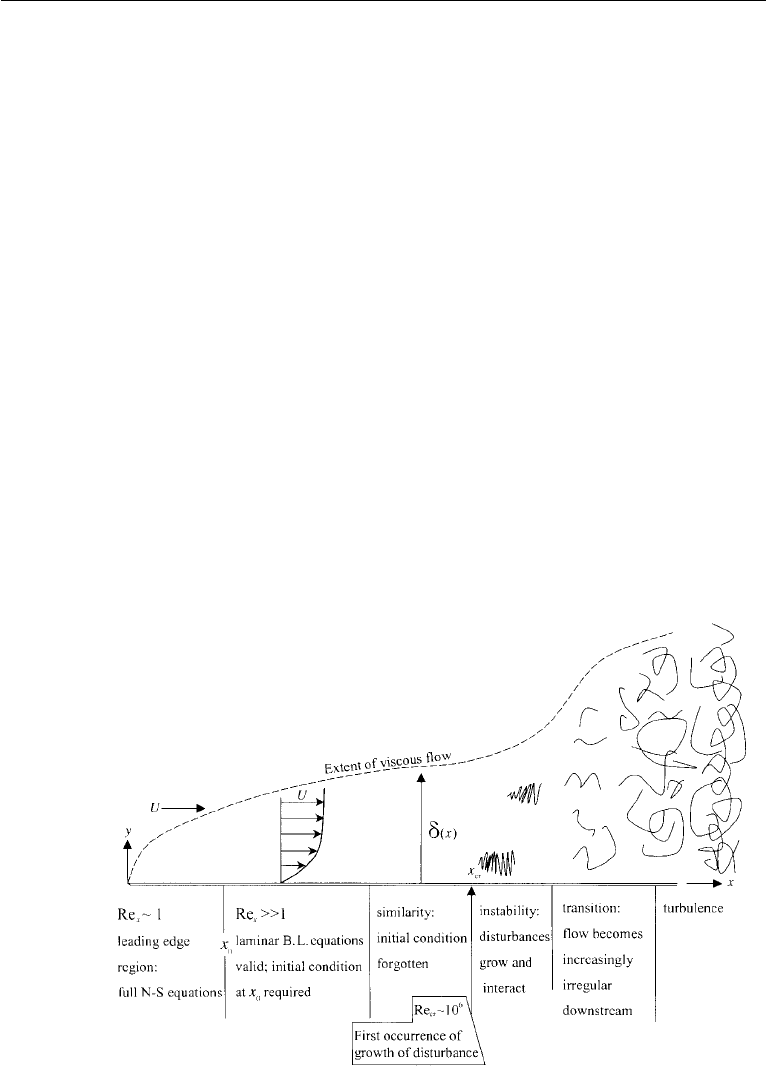
360 Boundary Layers and Related Topics
equations (10.8)–(10.15) must be solved. A simple approximate procedure, the von
Karman momentum integral, is discussed in the next section. More often the equa-
tions will be integrated numerically by procedures that are discussed in more detail in
Chapter 11.
Breakdown of Laminar Solution
Agreement of the Blasius solution with experimental data breaks down at large down-
stream distances where the local Reynolds number Re
x
is larger than some critical
value, say Re
cr
. At these Reynolds numbers the laminar flow becomes unstable and
a transition to turbulence takes place. The critical Reynolds number varies greatly
with the surface roughness, the intensity of existing fluctuations (that is, the degree
of steadiness) within the outer irrotational flow, and the shape of the leading edge.
For example, the critical Reynolds number becomes lower if either the roughness of
the wall surface or the intensity of fluctuations in the free stream is increased. Within
a factor of 5, the critical Reynolds number for a boundary layer over a flat plate is
found to be
Re
cr
∼ 10
6
(flat plate).
Figure 10.11 schematically depicts the flow regimes on a semi-infinite flat plate. For
finite Re
x
= Ux/ν ∼ 1, the full Navier–Stokes equations are required to describe the
leading edge region properly. As Re
x
gets large at the downstream limit of the leading
edge region, we can locate x
0
as the maximal upstream extent of the boundary layer
Figure 10.11 Schematic depiction of flow over a semiinfinite flat plate.
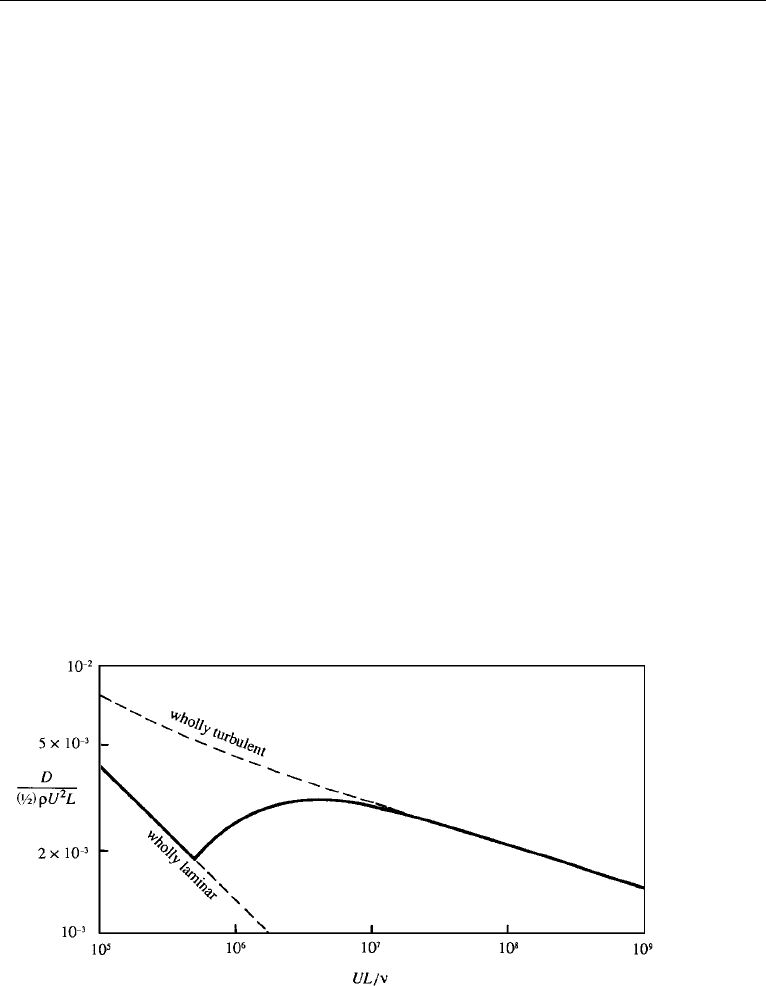
5. Boundary Layer on a Flat Plate: Blasius Solution 361
equations. For some distance x>x
0
, the initial condition is remembered. Finally,
the influence of the initial condition may be neglected and the solution becomes of
similarity form. For somewhat larger Re
x
, a bit farther downstream, the first instability
appears. Then a band of waves becomes amplified and interacts nonlinearly through
the advective acceleration. As Re
x
increases, the flow becomes increasingly chaotic
and irregular in the downstream direction. For lack of a better word, this is called
transition. Eventually, the boundary layer becomes fully turbulent with a significant
increase in shear stress at the plate τ
0
.
After undergoing transition, the boundary layer thickness grows faster than x
1/2
(Figure 10.11), and the wall shear stress increases faster with U than in a laminar
boundary layer; in contrast, the wall shear stress for a laminar boundary layer varies
as τ
0
∝ U
1.5
. The increase in resistance is due to the greater macroscopic mixing in
a turbulent flow.
Figure 10.12 sketches the nature of the observed variation of the drag coef-
ficient in a flow over a flat plate, as a function of the Reynolds number. The
lower curve applies if the boundary layer is laminar over the entire length of
the plate, and the upper curve applies if the boundary layer is turbulent over the
entire length. The curve joining the two applies if the boundary layer is laminar
over the initial part and turbulent over the remaining part, as in Figure 10.11. The
exact point at which the observed drag deviates from the wholly laminar behavior
depends on experimental conditions and the transition shown in Figure 10.12 is at
Re
cr
= 5 ×10
5
.
Figure 10.12 Measured drag coefficient for a boundary layer over a flat plate. The continuous line shows
the drag coefficient for a plate on which the flow is partly laminar and partly turbulent, with the transition
taking place at a position where the local Reynolds number is 5 ×10
5
. The dashed lines show the behavior
if the boundary layer was either completely laminar or completely turbulent over the entire length of the
plate.
